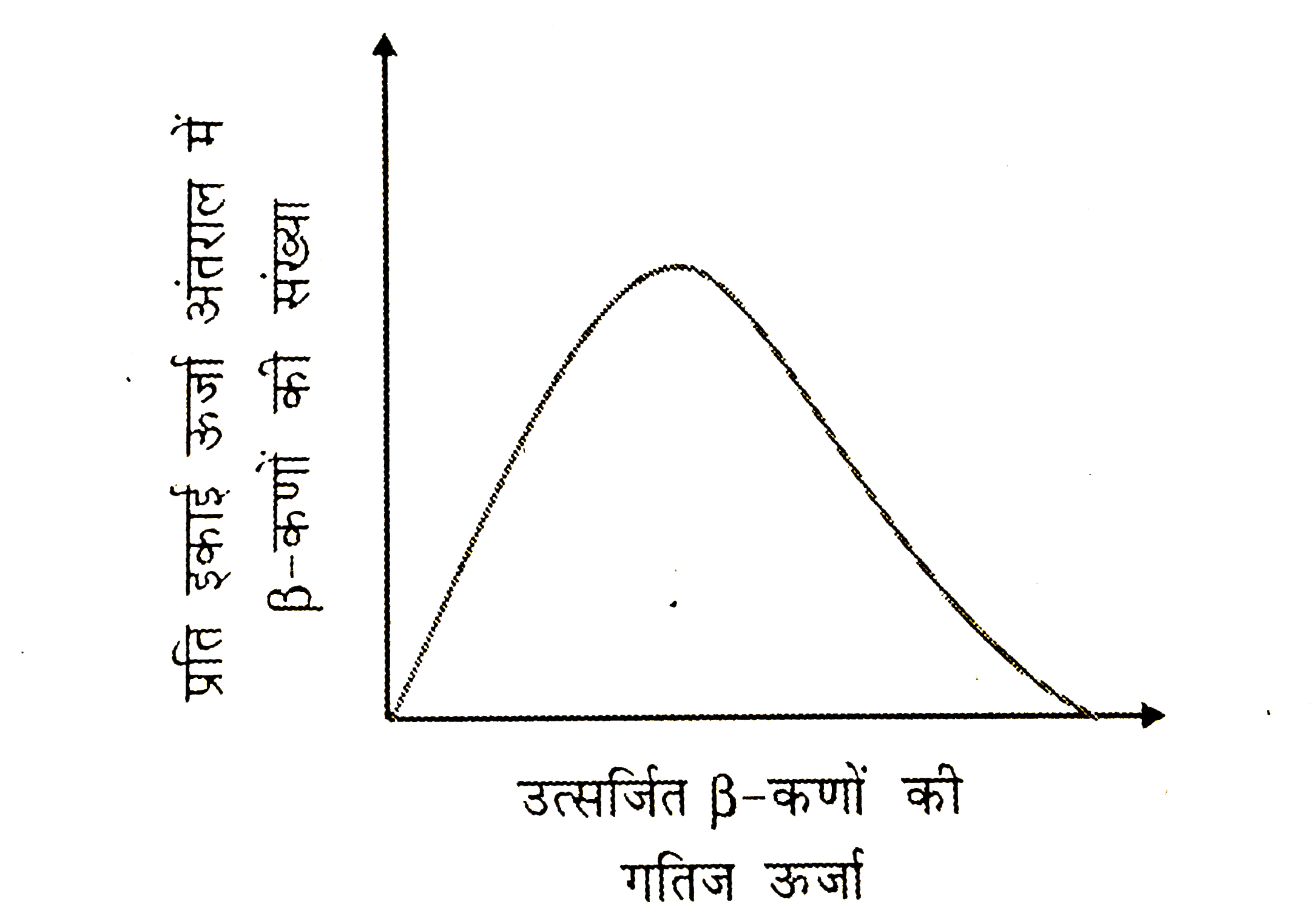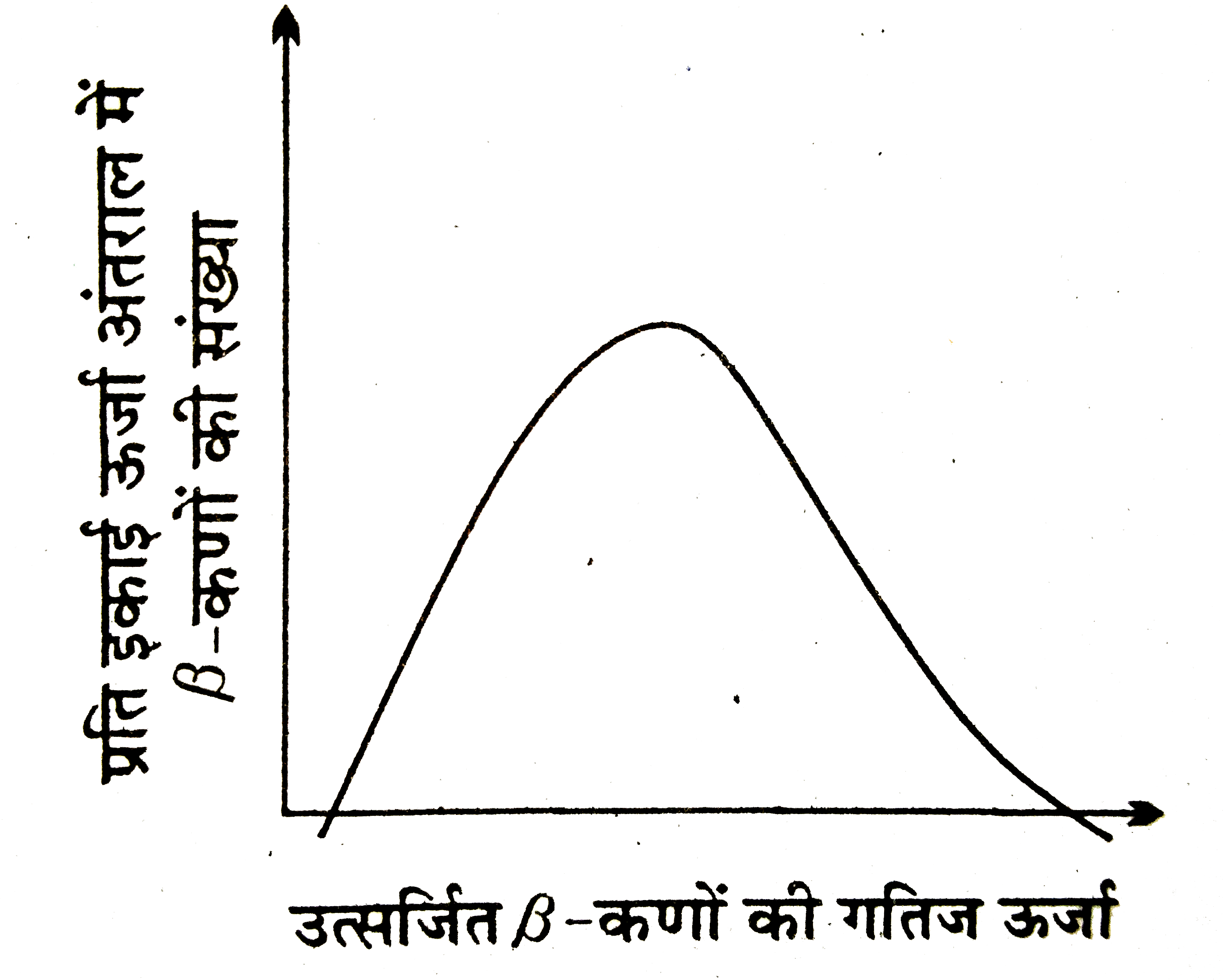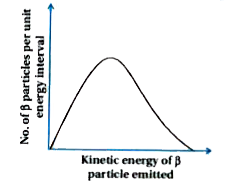The β-decay process, discovered around 1900, is basically the decay of a neutron (n), In the laboratory, a proton (p) and an electron (e−) are observed as the decay products of the neutron. Therefore, considering the decay of a neutron as a tro-body dcay process, it was observed that the electron kinetic energy has a continuous spectrum. Considering a three-body decay process i.e., n→p+e−+−ve, around 1930, Pauli explained the observed electron energy spectrum. Assuming the anti-neutrino (−Ve) to be massless and possessing negligible energy, and neutron to be at rest, momentum and energy conservation principles are applied. From this calculation, the maximum kinetic energy of the electron is 0.8×106eV. The kinetic energy carried by the proton is only the recoil energy.
What is the maximum energy of the anti-neutrino?
0≤K≤0.8×106eV
3.0eV≤K≤0.8×106eV
3.0eV≤K≤0.8×106eV
0≤K<0.8×106eV
The correct Answer is:D
Step by step video, text & image solution for The beta-decay process, discovered around 1900, is basically the decay of a neutron (n), In the laboratory, a proton (p) and an electron (e^(-)) are observed as the decay products of the neutron. Therefore, considering the decay of a neutron as a tro-body dcay process, it was observed that the electron kinetic energy has a continuous spectrum. Considering a three-body decay process i.e., n rarr p + e^(-)+overset(-)v_(e ), around 1930, Pauli explained the observed electron energy spectrum. Assuming the anti-neutrino (overset(-)V_(e )) to be massless and possessing negligible energy, and neutron to be at rest, momentum and energy conservation principles are applied. From this calculation, the maximum kinetic energy of the electron is 0.8xx10^(6)eV. The kinetic energy carried by the proton is only the recoil energy. What is the maximum energy of the anti-neutrino? by Physics experts to help you in doubts & scoring excellent marks in Class 12 exams.
Updated on:21/07/2023Topper's Solved these Questions
- JEE ADVANCEDBOOK - JEE ADVANCED PREVIOUS YEARCHAPTER - JEE ADVANCEDEXERCISE - Section III : Multiple Correct Answer(s) Type
6 Videos
- JEE ADVANCEDBOOK - JEE ADVANCED PREVIOUS YEARCHAPTER - JEE ADVANCEDEXERCISE - PART I : PHYSICS (SECTION -1)
10 Videos
- JEE ADVANCEDBOOK - JEE ADVANCED PREVIOUS YEARCHAPTER - JEE ADVANCEDEXERCISE - Section I : Single Correct Answer Type
7 Videos
- JEE (ADVANCE) 2020BOOK - JEE ADVANCED PREVIOUS YEARCHAPTER - JEE (ADVANCE) 2020EXERCISE - SECTION 3
6 Videos
- JEE ADVANCED 2020BOOK - JEE ADVANCED PREVIOUS YEARCHAPTER - JEE ADVANCED 2020EXERCISE - SECTION-3
6 Videos
Similar Questions
In the given circuit, the AC source has (ω)=100rad/s. Considering the inductor and capacitor to be ideal, the correct choice(s) is (are)
 .
.
View SolutionThe diameter of a cylinder is measured using a vernier callipers with no zero error . It is found that the zero of the vernier scale lies between 5.10and5.15cm of the main scale . The 24th division of the vernier scale exactly coincides with one of the main scale divisions . The diameter of the cylinder is
View SolutionA loop carrying current I lies in the x−y plane as shown in the figure . The unit vector ˆk is coming out of the plane of the paper . The magnetic moment of the current loop is

View SolutionA spherical bubbles inside water has radius R . Take the pressuere in the bubbled and the water pressure to be pv. The bubble now gets compressed radially in an adiabatic manner so that its raduis becomes (R - a) . For a<<R the magnitude of the work done in the process is given by (4πpoRa2)X. where X is a a constant and y=Cp/Cv=41/30. The value of X is
View SolutionPut a unifrom meter scale horizontally on your extended index fingers with the left one at 0.0 cm and the right one at 90.00 cm when you attempt to move both the fingers slowly towards the center , initially only the left finger slips with respect to to the scale and the right finger does not . after some distance, the left finger stops and the right one starts slipping . Then the right finger stops at a distance XR from the center (50.00 cm ) of the scale and the left one starts slopping again . This happens because to the difference in the fiictional forces on the two fingers . it the coefficients of static and dynamic between the fingers and the scale are 0.4 and 0.32 respectively , the value of XR (in cm is ...........
View SolutionThe beta - decay process , discoverwd around 1900 , is basically the decay of a neutron (n) in the laboratory , a proton (p) and an electron (e^(bar)) are observed as the decay that the kinetic energy of the electron should be a constant . But experimentally , if was observed that the electron kinectic energy has continuous spectrum Considering a three- body decay process , i.e. n rarr p + e^(bar) + bar nu _(e) , around 1930 , pauli expained the observed (bar nu_(e)) to be massaless and possessing negligible energy , and the neutrino to be at rest , momentum and energy conservation principle are applied from this calculate , the maximum kinectic energy of the electron is 0.8 xx 10^(6) eV The kinectic energy carrect by the proton is only the recoil energy If the - neutrono had a mass of 3 eV// c^(2) (where c is the speed of light ) insend of zero mass , what should be the range of the kinectic energy K. of the electron ?
View SolutionThe beta - decay process , discoverwd around 1900 , is basically the decay of a neutron (n) in the laboratory , a proton (p) and an electron (e^(bar)) are observed as the decay that the kinetic energy of the electron should be a constant . But experimentally , if was observed that the electron kinectic energy has continuous spectrum Considering a three- body decay process , i.e. n rarr p + e^(bar) + bar nu _(e) , around 1930 , pauli expained the observed (bar nu_(e)) to be massaless and possessing negligible energy , and the neutrino to be at rest , momentum and energy conservation principle are applied from this calculate , the maximum kinectic energy of the electron is 0.8 xx 10^(6) eV The kinectic energy carrect by the proton is only the recoil energy What is the maximum energy of the anti-neutrino ?
View SolutionConsider the decay of a freee neutron at rest :nrarrp+e^(-). . Show that the two body decay of this type must necessarily give an electron of fixed energy, and therefore, cannot account for the observed continuous energy distribution ini the beta- decay of a neutron in a nucleus, figure.
View SolutionA free neutron decays into a proton, an electron and
View SolutionThe beta -decay process, discovered around 1900 , is basically the decay of a neutron (n) , In the laboratory, a proton (p) and an electron (e^(-)) are observed as the decay products of the neutron. Therefore, considering the decay of a neutron as a tro-body dcay process, it was observed that the electron kinetic energy has a continuous spectrum. Considering a three-body decay process i.e., n rarr p + e^(-)+overset(-)v_(e ) , around 1930 , Pauli explained the observed electron energy spectrum. Assuming the anti-neutrino (overset(-)V_(e )) to be massless and possessing negligible energy, and neutron to be at rest, momentum and energy conservation principles are applied. From this calculation, the maximum kinetic energy of the electron is 0.8xx10^(6)eV . The kinetic energy carried by the proton is only the recoil energy. What is the maximum energy of the anti-neutrino?
View SolutionThe beta -decay process, discovered around 1900 , is basically the decay of a neutron (n) , In the laboratory, a proton (p) and an electron (e^(-)) are observed as the decay products of the neutron. Therefore, considering the decay of a neutron as a tro-body dcay process, it was observed that the electron kinetic energy has a continuous spectrum. Considering a three-body decay process i.e., n rarr p + e^(-)+overset(-)v_(e ) , around 1930 , Pauli explained the observed electron energy spectrum. Assuming the anti-neutrino (overset(-)V_(e )) to be massless and possessing negligible energy, and neutron to be at rest, momentum and energy conservation principles are applied. From this calculation, the maximum kinetic energy of the electron is 0.8xx10^(6)eV . The kinetic energy carried by the proton is only the recoil energy. If the anti-neutrino has a mass of 3eV//c^(2) (where c is the speed of light) instead of zero mass, what should be the range of the kinetic energy, K of the electron?
View SolutionConsider the decay of a free neutron at rest: n top+e^(-) Show that the tow-body dacay of this type must necessarily give an electron of fixed energy and, therefore, cannot for the observed continous energy distribution in the beta -decay of a neutron or a nucleus.
View Solutionविरामावस्था में किसी मुख्य न्यूट्रॉन के क्षय पर विचार कीजिए n→p+e−
प्रदर्शित कीजिए की इस प्रकार के द्विपिंड क्षय से नियत ऊर्जा का कोई इलेक्ट्रॉन अवश्य उत्सर्जित होना चाहिए , और इसलिए यह किसी न्यूट्रॉन या किसी नाभिक के - क्षय में प्रेक्षित सतत ऊर्जा वितरण का स्पष्टीकरण नहीं दे सकता (चित्र 6.19).

View Solutionविरामावस्था में किसी मुक्त न्यूट्रॉन के क्षय पर विचार कीजिए - n→p+e−
प्रदर्शित कीजिए कि इस प्रकार के द्विपिंड क्षय से नियत ऊर्जा का कोई इलेक्ट्रॉन अवश्य उत्सर्जित होना चाहिए और इसलिए यह किसी न्यूट्रॉन या किसी नाभिक के β− क्षय में प्रेक्षित सतत ऊर्जा वितरण का स्पष्टीकरण नहीं दे सकता ।

View SolutionConsider the decay of a free neutron at rest: n top+e^(-) Show that the tow-body dacay of this type must necessarily give an electron of fixed energy and, therefore, cannot for the observed continous energy distribution in the beta -decay of a neutron or a nucleus.
View SolutionConsider the decay of a free neutron at rest :
n→p+e−
Show that the two body decay of this type must necessary give an electron of fixed energy and therefore cannot account distribution in the β−decay of a neutron or a nucleous as shown in figure .

[ Note : The simple result of this exercise was one among the several arguments advanced by W . Pauli to perdict the existence of a third particle in the decay products of β− decay . This particle is known as neutrino spin 12 ( like e− p or n ) but is neutral ad either massless or having an extremely small mass (compared to the mass of electron) and which interacts very weakly with matter . The correct decay process of neutron is : n→p+e(−)+v)
View Solution
